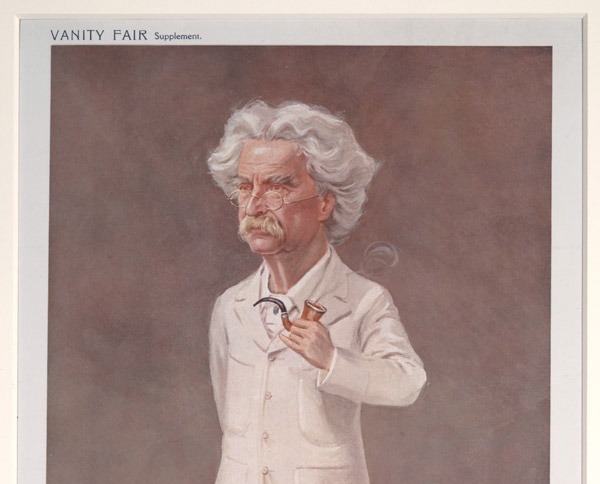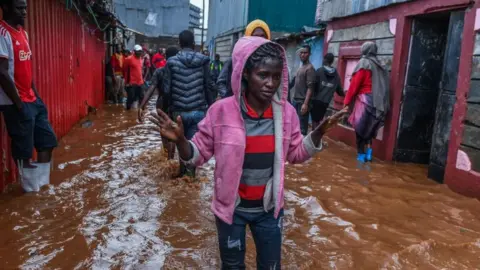Twain’s Anti-Imperialism and the Boxer Uprising

Caricature by Leslie Ward – Public Domain
The late 1890s were a time of acute social and economic upheaval in China. Foreign governments dramatically increased their economic penetration and influence in China during this period, and the Chinese suffered an embarrassing military defeat at the hands of Japan in a war that began in the summer 1894. Catastrophic floods of the Yellow River in the final years of the century devastated thousands of square miles and directly caused hundreds of thousands of deaths. Famine and disease followed in the wake of the floods, driving massive movements of people and leaving millions of peasants in the north of the country in conditions of extreme poverty. Amidst these overlapping crises, “1898 was a good year for the Christians,” and the missionaries added “a new threat to peasant well-being.”[1]That year also saw the political turbulence of the Hundred Days of Reform and its aftermath, in particular the coup d’état that made Empress Dowager Cixi the head of the Qing government.
It is within this context that the Boxer Uprising materializes. While the general circumstances surrounding the Uprising have become a familiar story to many in the United States, it is nonetheless poorly understood, our accounts shaped by Western chauvinism and the old, embarrassed desire to rationalize the brutality of the West’s efforts to “civilize” benighted foreigners. A popular romanization of the movement’s actual name is Yi-he quan, which has been translated as “righteous and harmonious fists.”[2] But the group was “dismissively known by members of the Western embassies”[3] in Beijing as the Boxers, owing to ritualistic martial arts practices to which confused westerners referred as “Chinese boxing.” As historian and China expert Joseph W. Esherick observes, the “boxing” of the Yi-he quan movement “was really a set of invulnerability rituals—to protect them from the powerful new weapons of the West.” Professor Esherick observes that even the popular name “Boxer Rebellion” is a misnomer pointing to a degree of historical misunderstanding, as the Boxers were never actively rebelling against the Qing dynasty and its Manchu ruling class.[4] As a matter of fact, the Boxers had expressed support of the Qing and had always made it explicit that theirs was a struggle against foreign influence generally and the Christian missionary presence in particular. The Qing dynasty likewise expressed its support for the boxers in 1900 as the Eight-Nation Alliance moved toward the capital, as discussed below.
At the time of a serious economic crisis, the Boxers observed the clear connection between burgeoning Christianity, propelled by ever-bolder missionary leaders, and the growing power of Western governments in their country. Just as many of the most important and sacred temples were being repurposed as churches by the Christian missionaries, so was much of China’s wealth being expropriated by the foreign powers. Their history and culture were being destroyed before their eyes while millions of Chinese sank into lower and lower states of poverty and need. Unlike many contemporary accounts, “[t]he classic works on modern China” correctly “stressed the crucial role of Western and Japanese imperialism” in reducing China to the crisis state of social and economic breakdown the country witnessed during the first half of the twentieth century.[5] The Boxer Uprising is among the most important events for developing an understanding of several related phenomena that continue to shape the world of today; it is one of the major immediate preludes to the decades-long conflict between the Kuomintang and the Chinese Communist Party, and it helps to explain current relations between China and the West, particularly the foreign policy of the United States as today’s dominant imperial power.
Through a combination of military pressure and economic coercion, the major powers of Europe had acquired strategically important pieces of territory and broad concessions of authority that allowed them power over tariffs and trade and supplanted local governments and laws in much of the country on important issues. Such grants of privilege to foreign governments, accomplished through a series of humiliating unequal treaties, had become a source of controversy, rightly resented by the Chinese population. The governments of the United Kingdom and France, for example, held some concessions in China for almost one-hundred years.
The Boxers were a genuinely decentralized, bottom-up, people’s uprising against a destructive, extractive economic system foisted upon Chinese people from without—a system that could not have been erected or maintained without war. The Boxers understood the connection between economic extraction and imperialistic wars better than most people do today, because they lived and observed that connection and its material consequences. Today’s war hawks and imperialists follow directly from the government elites of the major European powers of the nineteenth century and the turn of the century in pretending that there is an equivalence between high notions of free trade and gunboat diplomacy. The elites of the capitalist West believed it their clear and unquestionable prerogative to “open China,” and this they did through force, the language of “free trade” notwithstanding.
The Uprising’s crescendo was the Boxers’ siege of the international legations. Founded after China’s defeat in the Second Opium War, the Legation Quarter was an area of the capital city that was the prime real estate home to the diplomats of the foreign powers. The siege lasted almost two months during the summer of 1900, until the Boxers were overcome by the Eight Nation Alliance of Germany, Japan, Russia, Britain, France, the United States, Italy, and Austria-Hungary. The Eight Nation Alliance’s attacks on the Taku Forts in June of 1900 had led to the Qing government’s decision to support the Boxers in the fighting that took place at the legations. It is noteworthy that there was no formal declaration of war against China. Among the Eight-Nation Alliance, Japan committed far and away the largest number of troops, with over 20,000 of its soldiers descending upon the Chinese capital. Of the soldiers the British sent to the war, thousands were unwilling conscripts from India, forced at the point of a gun to a faraway war in which they held no stake. In the brutal aftermath of the Alliance’s victory at the capital city, suspected boxers were tortured and killed, often publicly decapitated. The Alliance’s looting remains legendary. An estimated 80% of Beijing’s cultural objects were either looted or destroyed. Missionaries, too, knew an opportunity to loot when they saw it, demanding indemnity payments for losses incurred during the Uprising; the payment amounts and terms reflected the power of the missionaries—they were new unequal treaties intended to punish local populations. They took whatever they could, reaping a massive windfall from the proceeds of the stolen booty. The excesses of one well-known missionary, William Scott Ament, made headlines back in the United States, particularly after Mark Twain entered the fray.
Published in the February 1901 issue of the North American Review, Twain’s satirical essay “To the Person Sitting in Darkness” addressed the controversy of the church engaging in the exploitative looting of China. In it, Twain skewered the ideological foundations of imperialism with characteristic trenchance, addressing the aftermath of the Boxer Uprising, and in particular the actions of Ament. A Congregationalist minister, Ament had left for China on a missionary effort shortly after his ordination in the fall of 1877. In China, Ament was the “ideal missionary,”[6] an able preacher in Mandarin Chinese who became one of the most influential missionaries in China. Twain regarded Ament as a moral hypocrite and fraud, and his treatment of the reverend was cuttingly sarcastic:
We all hold [Ament] dear for manfully defending his fellow missionaries from exaggerated charges which were beginning to distress us, but which his testimony has so considerably modified that we can now contemplate them without noticeable pain. For now we know that, even before the siege, the missionaries were not “generally” out looting, and that, “since the siege,” they have acted quite handsomely, except when “circumstances” crowded them. I am arranging for the monument.
Mark Twain was a key figure in the foundation of the American Anti-Imperialist League, becoming one of the organization’s Vice Presidents in 1901. He was a forceful and adamant opponent of war and imperialism and became a “red-hot anti-imperialist.”[7] In 1900, in a piece for the New York Herald, Twain had written of his conversion experience, remarking on his time as a “red-hot imperialist” who “wanted the American eagle to go screaming into the Pacific.” Twain soon came to understand that the mission of the U.S. government in the Philippines was the same old one, a mission not to free, but to subjugate—not to redeem, but to conquer. Twain’s experience reflects that of so many anti-war and anti-empire activists, who have been disabused of their jingoism by a growing awareness of history and respect for their fellow human beings.
In school, many received a boring, whitewashed version of Mark Twain—a humorist of bottomless wit certainly, and comfortably critical of American slavery and racism, but without a more comprehensive anti-authoritarian worldview. Though the ideological underpinnings of his anti-imperialism have been debated, Twain clearly understood a relationship between monopoly capitalism and imperialism.[8] The anti-imperialism that was so important a part of his life and character has been blotted out because it is not a fit with the worldview of a decadent, out-of-touch American ruling class. It is difficult to deny the judgment reached by R. Samarin in the 1950 article “The True Mark Twain,” which argued that America’s culture-makers had presented Twain “to the reading public in a false light,” promoting him as a shallow and “easy-going humorist.” Samarin contends that Twain’s indictments of capitalism and his “attack against the dictatorship of the dollar in American life” were deliberately buried.[9] His work for the League was incredibly important to him, and later in life, the failure of the anti-imperialist movement left Twain with an increasingly pessimistic and “despairing world view.”[10]
The American Anti-Imperialist League was founded in 1898 as a response to the ongoing Spanish-American war. The anti-imperialists’ platform protested against “the subjugation of the weak by the strong,” anticipating today’s critics of empire in resisting a so-called rules-based order that cynically ratifies the arbitrary violence of the hegemonic power. The organization’s members, though extremely diverse in background and ideology, understood well that embarking on a project of global conquest and empire would fundamentally change the character of America’s social, cultural, and political institutions, debasing and corrupting them. History has of course borne out their worries, as an increasingly powerful arms industry and ever-expanding military-industrial complex have neutralized and neutered democratic institutions in favor of a comparatively tiny elite. American society is now bereft of democracy. We have trillions of dollars for war-making while Americans go hungry and unhoused—and, crucially, this was both predictable and predicted by the anti-imperialists of over one-hundred years ago.
Charles Ames, a prominent member of the League and a Unitarian minister, warned that the quest for empire would mean a “trampling on the principles of free government,” making the United States “one more bully among bullies,” “only add[ing] one more to the list of oppressors of mankind.”[11] Ames represents another kind of Christian and man of the cloth, one who understood Jesus as a radical messenger for love and peace in a world racked by a sick, destructive obsession with purity and rules, the kind of ideology that divides people from one another. It is critical to understand the nuanced perspective with which the members of the American Anti-Imperialist League approached this subject: their opposition to war and empire was not only about the rights and freedoms of the people whose countries and cultures were being ravaged, though this was certainly a central aspect of their opposition. Crucially, it was also about the domestic upshots of empire, the politico-economic cementing of a permanent war machine incarnated as a standing army, a permanent military intelligence bureaucracy, and a nominally private war industry, well-connected to finance capital and political decision-makers. It was obvious to late nineteenth century American anti-imperialists that this conflux of organized and centralized incentives held the potential to foreclose the possibility of freedom and people’s government.
The connection between imperialism and racial animus was also always clear to those paying attention. It is impossible to manufacture public support for the conquest of faraway lands and peoples without cultivating the pretense of ethnic and cultural superiority, the idea that the imperial power actually helps the conquered by sharing its more advanced culture. Both President William McKinley and President Theodore Roosevelt attempted to buoy their unpopular war-making by “branding their Filipino foes as little better than ungrateful savages,”[12] just as the American and European press had reported on the Boxers with already-established racist tropes, appealing to scare tactics associated with characterizing Asians as “the Yellow Peril.” As there is today, there was much overlap a century ago between the anti-imperialist movement and activism for equality of rights under the law between racial and ethnic groups.
Moorfield Storey is among the most important figures in the history of the League, serving as its President from 1905 until the final days of the organization in 1921. Storey is more well-known as among the founding members of the NAACP, serving as its first president from the organization’s founding in 1910 until he died in 1929. Storey was a pioneer in the use of targeted, strategic litigation to secure civil rights victories and raise awareness of important civil rights issues (later taken up by the ACLU and others), and he was instrumental in bringing an end to the exclusion of Black Americans from the American Bar Association.[13] He believed that domestic racial violence and domination were intimately connected with a broader way of thinking in which a ruling class formulates an ideology of both economic and ethnic stratification, with a ruling class using ideology to manufacture consent among the middle classes for a profoundly violent and immoral system. In this thinking, he was of course many decades ahead of his time.
Our political and media class, even (perhaps especially) our liberals, harbors a system of belief not so very different from the one held by the turn-of-the-century imperialists against whom Twain railed. They continue to believe, against all available evidence, that we’ve arrived at a kind of end of history, that Washington should, indeed must, project America’s cultural, political, and economic paradigm around the world—as a boon to the world. As the late Palestinian-American scholar and activist Edward Said observed over 20 years ago, this is all predicated on “the theory that imperialism is a benign and necessary thing,” the ability of the oppressor to see itself as “unlike all other empires,” with a mission “not to plunder and control but to educate and liberate.” Notwithstanding its proponents’ pretenses to enlightened liberalism, this is a philosophy that proceeds in direct continuity from the one underpinning the genocide of the peoples the Spanish and English wiped out in the Americas. Today’s colonial enterprises demonstrate that we are not nearly as far from these ideologies of racial hierarchy and extreme violence as we think. Most people in the white, educated West have committed themselves to a vast complex of politics to which they don’t realize they’ve committed themselves. Imperialism and colonialism are fundamentally attempts to define and establish one’s own culture as the foundation of or condition precedent to the cultures of other peoples. Inequality is always at the center of such projects.
But across time, people everywhere have desired self-determination and organized within their communities to resist the subjugation and oppression of foreign rulers. For wanting just what we all want and expect, they have been hatefully slurred as uncivilized, as animals, terrorists, savages, rebels, criminals, and subversives. But they never sought the violent domination of conquering foreign nations looking for resources to plunder. The modern era’s imperial powers have always feigned shock that the peoples they want to steal from and sentence to permanent second-class status in their own homelands are not ready to welcome them with open arms. In the world that is emerging now, a more grounded geopolitical posture will be an absolute imperative for the United States, particularly after the massive loss of respect and legitimacy that will come from the rest of the world now.
We are entering a new moment of global discontent with the arrogance and license of an increasingly brutal imperial order.
Like those who fight for freedom today, the Boxers didn’t need to be taught revolutionary consciousness. They wanted to protect their families, their home, and their way of life. They understood something philosopher Chantelle Gray observed in a recent interview: “Revolution is not something that is this kind of event,” but is rather “something that we practice in the here and now, individually, together, all the time” as “a persistent action towards freedom—towards more freedom.” They understood and lived this intuitively. Twain famously referred to himself as a Boxer and wished the movement success, calling the Boxers patriots. We must learn to see today’s Boxers in the same light.
Notes.
[1] Joseph W. Esherick, The Origins of the Boxer Uprising (University of California Press 1987), page 185.
[2] To avoid confusion, I’ve chosen to refer to the movement as the Boxers here, rather than using their actual name.
[3] David J. Silbey, The Boxer Rebellion and the Great Game in China: A History (Hill and Wang 2012).
[4] Joseph W. Esherick, The Origins of the Boxer Uprising (University of California Press 1987), page xiv.
[5] As against the view, growing in popularity at the time of Esherick’s article in 1972, that “imperialism fostered economic development, progressive Western-style nationalism and institutional modernization.”
[6] Larry Clinton Thompson, William Scott Ament and the Boxer Rebellion: Heroism, Hubris and the “Ideal Missionary”(McFarland & Company 2009), page 2.
[7] Selina Lai-Henderson, Mark Twain in China (2015 Stanford University Press).
[8] John Carlos Rowe, Literary Culture and U.S. Imperialism: From the Revolution to World War II (Oxford University Press 2000), page 134.
[9] James L. Machor, The Mercurial Mark Twain(s): Reception History, Audience Engagement, and Iconic Authorship (Routledge 2023).
[10] Hunt Hawkins. “Mark Twain’s Anti-Imperialism.” American Literary Realism, 1870-1910, vol. 25, no. 2, 1993, pp. 31–45. In 1906, Twain writes, “The woes of the wronged and unfortunate poison my
life and make it so undesirable that pretty often I wish I were 90 instead of 70.”
[11] Stephen Kinzer, The True Flag: Theodore Roosevelt, Mark Twain, and the Birth of American Empire (Henry Holt and Company 2017).
[12] Kenneth Osgood, Andrew K. Frank, Selling War in a Media Age: The Presidency and Public Opinion in the American Century(University Press of Florida 2010).
[13] Paul Finkelman, ed. American Encyclopedia of Civil Liberties: Volume 3, R-Z (Routledge 2018), page 1571.








